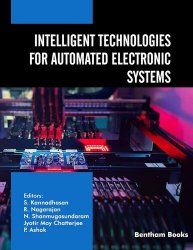Intelligent Technologies for Automated Electronic Systems
- Добавил: literator
- Дата: 16-04-2024, 03:30
- Комментариев: 0
 Название: Intelligent Technologies for Automated Electronic Systems
Название: Intelligent Technologies for Automated Electronic SystemsАвтор: S. Kannadhasan, R. Nagarajan, N. Shanmugasundaram, Jyotir Moy Chatterjee
Издательство: Bentham Books
Год: 2024
Страниц: 234
Язык: английский
Формат: pdf (true)
Размер: 48.4 MB
This volume explores a diverse range of applications for automated Machine Learning and predictive analytics. The content provides use cases for Machine Learning in different industries such as healthcare, agriculture, cybersecurity, computing and transportation.
The major objective of Smart Electronic Systems is to provide a platform where researchers from the fields of hardware and software may work together under one roof to speed up the development of smart electronic systems. Effective and secure data sensing, storage, and processing are essential in today's information age. Modern smart electronic systems meet the criteria of effective sensing, storage, and processing. Effective techniques and software that allow for a quicker analysis and retrieval of necessary data are simultaneously becoming more important. The internet world now includes big data, which comprises large, complex data collections. It is becoming harder to store and analyse the vast amount of structured and unstructured data that has to be collected. With concurrent hardware and software development, the Internet of Things (IoT) and cyber-physical systems (CPS) have been growing to include everyday consumer electronics. The effectiveness and performance of current and next generations of computing and information processing systems depend on advancements in both hardware and software. Some of the focused areas in this field include memristor and memristive systems, advanced 3D IC technologies, design methodologies, and 3D pacing. Others include molecular electronics, biosensors, bio-molecular and biologically inspired computing, nanoelectronics for energy harvesting, spintronics, domain-wall and phase-change memories, and nanoelectronics for energy harvesting. Quantum computing, communication, information processing, circuit, system, and sensor design based on nanoelectronics for critical applications, chip-to-system design, and techniques for electronic design automation (EDA) or computer-aided design (CAD) are the topics addressed in this book. At the same time, programming and efficient calculations for quicker examination and retrieval of crucial data are slowly getting out of style.
Massive amounts of both organised and unstructured data are challenging to store and manage. Post-CMOS technologies, the Internet of Things (IoT), and the cyber-physical system (CPS) have all been advancing simultaneously with synchronous hardware and software developments and have surpassed standard client devices. Future ages of figuring and data processing frameworks, as well as the present generation, will be largely influenced by advancements in both design and programming. In order to exchange information and research discoveries on all facets of electronic systems and digital electronics, it aims to bring together eminent academic scientists, researchers, and research scholars. It also acts as a premier interdisciplinary platform where researchers, practitioners, and educators may discuss and present the most recent findings, challenges, and trends in the fields of analogue and digital electronic systems, as well as their applications and solutions.
Chapter 1 introduces an innovative device for automatically notifying and analyzing the impact of automobile accidents. Chapter 2 focuses on the detection of malaria using systematized image processing techniques. In Chapter 3, an intelligent technique based on LMEPOP and fuzzy logic for the segmentation of defocus blur is discussed. Predictive analytics is introduced in Chapter 4, providing an overview of this emerging field. Chapter 5 delves into discrete event system simulation, offering insights into its applications.
The performance analysis of different hypervisors in OS virtualization is explored in Chapter 6. Load balancing in cloud computing is the subject of investigation in Chapter 7. Chapter 8 presents a survey on a facial and fingerprint-based voting system utilizing Deep Learning techniques. Chapter 9 explores IoT-based automated decision-making with data analytics in agriculture. Biometric recognition through modality fusion is investigated in Chapter 10. Chapter 11 offers a new perspective on evaluating Machine Learning algorithms for predicting employee performance. Pre-process methods for cardiovascular diseases diagnosis using CT angiography images are discussed in Chapter 12. Chapter 13 presents the implementation of a smart wheelchair using ultrasonic sensors and LabVIEW.
Cryptography using the Internet of Things is the focus of Chapter 14. Chapter 15 explores Machine Learning applications for traffic sign recognition, and the book concludes with Chapter 16, which analyzes Machine Learning algorithms in healthcare.
The book is a resource for academics, researchers, educators and professionals in the technology sector who want to learn about current trends in intelligent technologies.
Скачать Intelligent Technologies for Automated Electronic Systems
Внимание
Уважаемый посетитель, Вы зашли на сайт как незарегистрированный пользователь.
Мы рекомендуем Вам зарегистрироваться либо войти на сайт под своим именем.
Уважаемый посетитель, Вы зашли на сайт как незарегистрированный пользователь.
Мы рекомендуем Вам зарегистрироваться либо войти на сайт под своим именем.
Информация
Посетители, находящиеся в группе Гости, не могут оставлять комментарии к данной публикации.
Посетители, находящиеся в группе Гости, не могут оставлять комментарии к данной публикации.
